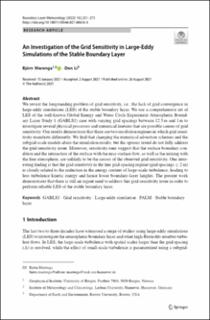| dc.contributor.author | Maronga, Bjørn | |
| dc.contributor.author | Li, Dan | |
| dc.date.accessioned | 2022-03-24T12:53:00Z | |
| dc.date.available | 2022-03-24T12:53:00Z | |
| dc.date.created | 2022-02-02T10:40:32Z | |
| dc.date.issued | 2021 | |
| dc.identifier.issn | 0006-8314 | |
| dc.identifier.uri | https://hdl.handle.net/11250/2987390 | |
| dc.description.abstract | We revisit the longstanding problem of grid sensitivity, i.e., the lack of grid convergence in large-eddy simulations (LES) of the stable boundary layer. We use a comprehensive set of LES of the well-known Global Energy and Water Cycle Experiment Atmospheric Boundary Layer Study 1 (GABLS1) case with varying grid spacings between 12.5 m and 1 m to investigate several physical processes and numerical features that are possible causes of grid sensitivity. Our results demonstrate that there are two resolution regimes in which grid sensitivity manifests differently. We find that changing the numerical advection schemes and the subgrid-scale models alters the simulation results, but the options tested do not fully address the grid-sensitivity issue. Moreover, sensitivity runs suggest that the surface boundary condition and the interaction of the surface with the near-surface flow, as well as the mixing with the free atmosphere, are unlikely to be the causes of the observed grid sensitivity. One interesting finding is that the grid sensitivity in the fine grid-spacing regime (grid spacings ≤2m) is closely related to the reduction in the energy content of large-scale turbulence, leading to less turbulence kinetic energy and hence lower boundary-layer heights. The present work demonstrates that there is still an urgent need to address this grid-sensitivity issue in order to perform reliable LES of the stable boundary layer. | en_US |
| dc.language.iso | eng | en_US |
| dc.publisher | Springer | en_US |
| dc.rights | Navngivelse 4.0 Internasjonal | * |
| dc.rights.uri | http://creativecommons.org/licenses/by/4.0/deed.no | * |
| dc.title | An Investigation of the Grid Sensitivity in Large-Eddy Simulations of the Stable Boundary Layer | en_US |
| dc.type | Journal article | en_US |
| dc.type | Peer reviewed | en_US |
| dc.description.version | publishedVersion | en_US |
| dc.rights.holder | Copyright The Author(s) 2021 | en_US |
| cristin.ispublished | true | |
| cristin.fulltext | original | |
| cristin.qualitycode | 1 | |
| dc.identifier.doi | 10.1007/s10546-021-00656-8 | |
| dc.identifier.cristin | 1996835 | |
| dc.source.journal | Boundary-Layer Meteorology | en_US |
| dc.source.pagenumber | 251-273 | en_US |
| dc.identifier.citation | Boundary-Layer Meteorology. 2021, 182, 251-273. | en_US |
| dc.source.volume | 182 | en_US |

